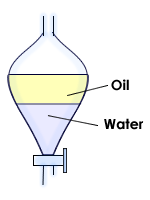Extraction (chemistry)


Extraction in chemistry is a separation process consisting in the separation of a substance from a matrix. It includes Liquid-liquid extraction, and Solid phase extraction.
Types of extraction
There exist several types of extraction, including: liquid-liquid extraction, solid-phase extraction, solid-phase microextraction, Soxhlet extraction, fizzy extraction.
Components of an extractive process
Extractions often use two immiscible phases to separate a solute from one phase into the other. Typical lab extractions are of organic compounds out of an aqueous phase and into an organic phase. Common extractants are arranged from ethyl acetate to water (ethyl acetate < acetone < ethanol < methanol < acetone:water (7:3) < ethanol:water (8:2) < methanol:water (8:2) < water) in increasing order of polarity according to the Hildebrand solubility parameter. The extract can be put back to dried form using a centrifugal evaporator or a freeze-drier.
Theory of an extraction between two phases
The distribution of a solute between two phases is an equilibrium condition described by partition theory. This is based on exactly how the analyte move from the water into an organic layer
Modern variations
Techniques include supercritical carbon dioxide extraction, ultrasonic extraction, heat reflux extraction, microwave-assisted extraction, instant controlled pressure drop extraction (DIC), and perstraction.
Applications
Boiling tea leaves in water extracts the tannins, theobromine, and caffeine out of the leaves and into the water. Solid-liquid extractions at laboratory scales can use Soxhlet extractors (such as oil from olive cakesee at right).
Further reading
- Gunt Hamburg, 2014, Thermal Process Engineering: Liquid-liquid extraction and solid-liquid extraction, see , accessed 12 May 2014.
- G.W. Stevens, T.C., Lo, & M. H. I. Baird, 2007, "Extraction, Liquid-Liquid", in Kirk-Othmer Encyclopedia of Chemical Technology, DOI: 10.1002/0471238961.120917211215.a01.pub2, see , accessed 12 May 2014.
- T. Voeste, K. Weber, B. Hiskey & G. Brunner, 2006, "Liquid–Solid Extraction", in Ullmann's Encyclopedia of Industrial Chemistry, DOI: 10.1002/14356007.b03_07.pub2, see , accessed 12 May 2014.
- R. J. Wakeman, 2000, "Extraction, Liquid-Solid", in Kirk-Othmer Encyclopedia of Chemical Technology, DOI: 10.1002/0471238961.1209172123011105.a01, see , accessed 12 May 2014.
- M.J.M. Wells, 2000, "Essential guides to method development in solid-phase extraction," in Encyclopedia of Separation Science, Vol. 10 (I.D. Wilson, E.R. Adlard, M. Cooke, and C.F. Poole, eds.), London:Academic Press, London, 2000, pp. 4636–4643.
- Colin Poole & Michael Cooke, 2000, Extraction, in Encyclopedia of Separation Science, 10 Vols., ISBN 9780122267703, see , accessed 12 May 2014.
